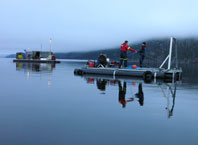|
One of the most daring clandestine operations of World War II was
the 1944 sinking of the Norwegian ferry Hydro with its cargo
of "heavy water" destined for the Nazis' secret atomic bomb project.
Although the mission was declared a success, no one ever established
if the special shipment was actually on board. In this program, NOVA
descends 1,300 feet beneath a remote Norwegian lake to find the
answer.
Exploring the pristine lake bottom with a remotely operated vehicle,
the expedition team locates the remarkably well-preserved ship,
along with evidence of a mysterious cargo in steel drums. Analysis
of the contents of one of those drums will solve a six-decade-long
mystery about the role the Allies played in preventing a Nazi
nuclear bomb.
The program features participants in the Hydro affair,
including a member of the Norwegian Resistance who slipped aboard
the vessel on the night of February 21, 1944, and helped plant
explosives in the bow that were timed to go off the following day
when the ferry was over the deepest part of Lake Tinn. Intelligence
had indicated that the Hydro would be transporting railroad
flatcars loaded with barrels of heavy water produced by the nearby
Norsk hydroelectric plant, which at that time was the world's
largest power station. The Germans had conquered Norway early in the
war and immediately ordered the Norsk plant to double its output of
heavy water.
Crucial to the Nazi nuclear program, heavy water was extracted from
ordinary water by using electricity to break apart ordinary water
molecules and concentrating the solution until all that remained was
the rare, heavier form of the liquid. With a bigger, "heavier"
nucleus than ordinary water, heavy water was an ideal substance for
slowing neutrons in a nuclear reactor, a key step in triggering a
chain reaction (see
Dangerous Water).
With a sufficient supply of heavy water and uranium, the Germans
could use reactors to produce bomb-grade material for nuclear
weapons that would render the Third Reich invincible. Fear of that
outcome sparked the Allies to undertake their own crash program.
This became the Manhattan Project, which ultimately produced the
first atomic bomb.
The Norwegian partisans had no inkling of the reason for their
mission. All they knew was that it had top priority from their
contact in London and that innocent Norwegian civilians were likely
to be aboard on the last, fatal voyage of the Hydro. (To read
actual telegrams sent between the saboteurs and their chiefs in
London, go to
See the Spy Messages.)
NOVA interviews one of the civilians who survived the sinking and
who remembers seeing barrels floating among the debris. These
barrels were immediately recovered by the Germans and shipped to
Berlin. However, had they been filled with heavy water they should
have sunk, not floated. This is just one of the mysteries NOVA
solves by snaring a barrel, bringing it to the surface, and seeing
just what's inside.


|


|
The NOVA team prepares to salvage a barrel from the
sunken Hydro, which has lain on the bed of
Norway's Lake Tinn for 60 years.

|
|
|

